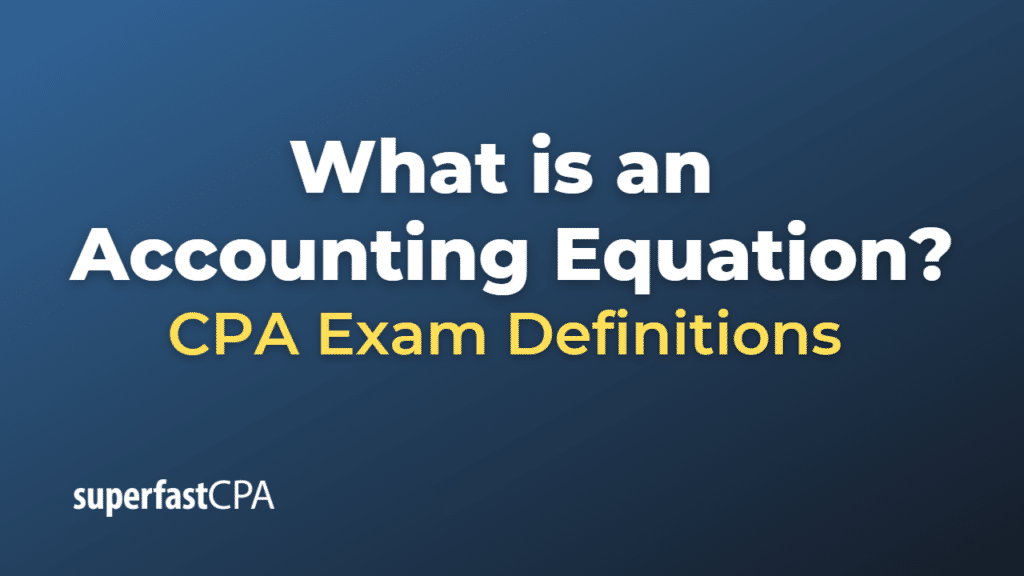Accounting Equation
The accounting equation, also known as the basic accounting equation or the balance sheet equation, is a fundamental principle in accounting that represents the relationship between a company’s assets, liabilities, and equity. The accounting equation is the foundation of double-entry bookkeeping, which is used to maintain the integrity and accuracy of a company’s financial records.
The accounting equation is expressed as:
Assets = Liabilities + Equity
Here’s a brief explanation of each component:
- Assets: Assets are the resources owned or controlled by a company that have future economic value. These can include cash, accounts receivable, inventory, buildings, land, equipment, and other tangible or intangible items.
- Liabilities: Liabilities are the obligations or debts that a company owes to others, such as loans, accounts payable, salaries payable, taxes payable, and other outstanding obligations. Liabilities represent claims against the company’s assets by external parties.
- Equity: Equity, also known as owner’s equity or shareholder’s equity, represents the residual interest in the assets of a company after deducting liabilities. It’s the owner’s claim to the company’s assets and includes items such as contributed capital (e.g., common stock), retained earnings, and other comprehensive income.
The accounting equation ensures that a company’s financial records are always in balance, as every financial transaction affects at least two accounts in a way that maintains the equality of the equation. In the double-entry bookkeeping system, each transaction has an equal and opposite effect on at least two accounts, with one account being debited and another account being credited.
The accounting equation is essential for understanding a company’s financial position, as it provides a snapshot of the company’s resources (assets) and the claims against those resources (liabilities and equity). By analyzing the accounting equation, investors, creditors, and other stakeholders can gain insight into a company’s financial health and make informed decisions.
Example of an Accounting Equation
Let’s consider a fictional example of a small startup called “TechGuru Inc.” to illustrate the accounting equation.
TechGuru Inc. has the following financial information:
- Assets:
- Cash: $50,000
- Accounts Receivable: $30,000
- Inventory: $20,000
- Equipment: $100,000
- Liabilities:
- Accounts Payable: $25,000
- Bank Loan: $70,000
- Equity:
- Common Stock: $80,000
- Retained Earnings: $25,000
Using the accounting equation, we can verify that the company’s financial records are in balance:
Assets = Liabilities + Equity
Total Assets: $50,000 (Cash) + $30,000 (Accounts Receivable) + $20,000 (Inventory) + $100,000 (Equipment) = $200,000
Total Liabilities: $25,000 (Accounts Payable) + $70,000 (Bank Loan) = $95,000
Total Equity: $80,000 (Common Stock) + $25,000 (Retained Earnings) = $105,000
Now, we plug the numbers into the equation:
$200,000 (Assets) = $95,000 (Liabilities) + $105,000 (Equity)
As the equation balances, we can confirm that TechGuru Inc.’s financial records are accurate and properly maintained.
Let’s consider a new transaction: TechGuru Inc. purchases new computers for $10,000 cash. To maintain the accounting equation balance, the transaction would affect both the company’s assets (a decrease in cash and an increase in equipment) and would not impact liabilities or equity.
New Assets:
- Cash: $50,000 – $10,000 (purchase of computers) = $40,000
- Equipment: $100,000 + $10,000 (purchase of computers) = $110,000
The updated accounting equation will look like this:
$210,000 (New Total Assets) = $95,000 (Liabilities) + $105,000 (Equity)
As we can see, the accounting equation remains in balance after recording the transaction, demonstrating the fundamental principle of double-entry bookkeeping and the accounting equation in action.













